Two Decades of Child Welfare System Contact in the Global North: A Research Note on Trends in 44 Countries
- PMID: 39898618
- PMCID: PMC12165327
- DOI: 10.1215/00703370-11793609
Two Decades of Child Welfare System Contact in the Global North: A Research Note on Trends in 44 Countries
Abstract
Child maltreatment and child welfare system contact are both associated with an elevated risk of adverse outcomes in childhood, adolescence, and adulthood. Yet, data on variation in system contact are available for only a handful of countries, limiting knowledge about the societal correlates of system contact. As reported in this research note, we identified, collected, and harmonized administrative data on child welfare agency investigations, confirmed maltreatment, and placements into out-of-home care for 44 countries in the Global North. We analyzed 15 sociodemographic factors commonly associated with child maltreatment and child welfare system contact. Results support three core conclusions. First, data are much more available on late-stage system contact (e.g., foster care caseloads) than for early-stage system contact (e.g., investigations). Second, whereas early-stage contact tended to be on the rise in most countries, late-stage contact was stable or declining. Cross-national variation in these trends was generally less substantial than cross-national variation in levels of child welfare system contact, indicating relatively stable cross-national differences. Third, cross-national variation in out-of-home care largely reflected, but was not reducible to, regional and sociocultural variation: we find little evidence for universal drivers of foster care caseloads across the Global North.
Keywords: Administrative data; Child maltreatment; Child welfare; Cross-national research; Foster care.
Copyright © 2025 The Authors.
Figures





Similar articles
-
Trends in child protection and out-of-home care.Pediatrics. 2013 Oct;132(4):712-9. doi: 10.1542/peds.2013-0969. Epub 2013 Sep 23. Pediatrics. 2013. PMID: 24062369 Free PMC article.
-
The foster care crisis: what caused caseloads to grow?Demography. 2006 May;43(2):309-35. doi: 10.1353/dem.2006.0019. Demography. 2006. PMID: 16889131
-
Child welfare services involvement among the children of young parents in foster care.Child Abuse Negl. 2015 Jul;45:68-79. doi: 10.1016/j.chiabu.2015.04.005. Epub 2015 Apr 21. Child Abuse Negl. 2015. PMID: 25907333
-
An out-of-home care system in crisis: implications for African American children in the child welfare system.Child Welfare. 1997 Jan-Feb;76(1):65-83. Child Welfare. 1997. PMID: 8995780 Review.
-
Depression in Children and Adolescents Involved in the Child Welfare System.Child Adolesc Psychiatr Clin N Am. 2019 Jul;28(3):303-314. doi: 10.1016/j.chc.2019.02.001. Epub 2019 Apr 4. Child Adolesc Psychiatr Clin N Am. 2019. PMID: 31076109 Review.
Cited by
-
Out-of-home care placement, psychiatric disorders, and risk of homelessness: a population-based cohort study.Lancet Reg Health Eur. 2025 Jul 22;56:101381. doi: 10.1016/j.lanepe.2025.101381. eCollection 2025 Sep. Lancet Reg Health Eur. 2025. PMID: 40735377 Free PMC article.
References
-
- Australia Institute of Health and Welfare. (2024, May 7). Child protection Australia 2021–22. Retrieved from https://www.aihw.gov.au/reports/child-protection/child-protection-austra...
-
- Berger LM, & Waldfogel J (2004). Out-of-home placement of children and economic factors: An empirical analysis. Review of Economics of the Household, 2, 387–411.
-
- Carson EA (2020). Prisoners in 2019 (Office of Justice Programs Bulletin, No. NCJ 255115). U.S. Department of Justice, Bureau of Justice Statistics. Retrieved from https://bjs.ojp.gov/content/pub/pdf/p19.pdf
-
- Conti G, Pizzo E, Morris S, & Melnychuk M (2021). The economic costs of child maltreatment in UK. Health Economics, 30, 3087–3105. - PubMed
MeSH terms
Grants and funding
LinkOut - more resources
Full Text Sources
Medical
Research Materials
